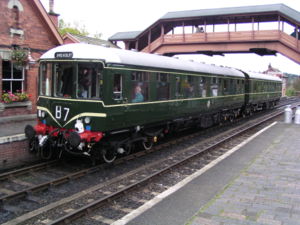British Rail Class 104
| British Rail Class 104 | |
|---|---|
 Class 104, nos. 50517 and 50455, at Bewdley on the Severn Valley Railway, on 15 October 2004, whilst taking part in the Railcar 50 event. This unit has been returned to service, and is preserved on the Churnet Valley Railway. | |
| In service | 1957–1993 |
| Manufacturer | Birmingham RC&W |
| Constructed | 1957–1959 |
| Number built | 71 DMBS, 52 DMCL, 15 DTCL, 56 TCL, 26 TBSL, 26 TSL. Total: 302 cars |
| Formation | 2 car sets: DMBS-DTCL 3 car sets: DMBS-TCL-DMCL 4 cars sets:DMCL-TSL-TBSL-DMCL |
| Capacity | DMBS: 52, DMCL/DTCL: 12F 51S, TCL: 12F 54, TBSL: 51, TSL: 69 |
| Operator(s) | British Rail |
| Specifications | |
| Car length | 57 ft 6 in (17.53 m) |
| Width | 9 ft 3 in (2.82 m) |
| Maximum speed | 70 mph (113 km/h) |
| Weight | DMCL/DMBS: 31 long tons (31.5 t), TBSL: 25 long tons (25.4 t), DTCL/TCL/TSL: 24 long tons (24.4 t) |
| Prime mover(s) | Two B.U.T. (Leyland) 6-cylinder diesels of 150 bhp each |
| Power output | 300 bhp (220 kW) |
| Transmission | Mechanical: 4 speed epicyclic gearbox |
| Braking system(s) | Vacuum |
| Safety system(s) | Automatic Warning System |
| Track gauge | 4 ft 8 1⁄2 in (1,435 mm) |
The British Rail Class 104 diesel multiple units were built by Birmingham Railway Carriage and Wagon Company from 1957 to 1959.
The first units ordered were for the London Midland Region, with the majority of the class for use in North West of England with sets also in Tyneside (being made redundant by the opening of the Tyne & Wear Metro in 1980). In the mid-1980s a few units reallocated to Scotland, with one unit being repainted in a unique maroon and white livery for services to Oban - it became known as the "Mexican Bean". Other vehicles spent time in London and the last vehicles could be found there in the early 1990s.
The class was gradually taken of service from the early 1980s. The final vehicles were withdrawn in 1995.
